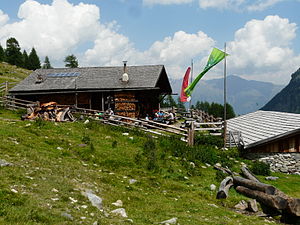Upper Laaser Alm
| Obere Laaser Alm AVS hut |
||
|---|---|---|
|
Upper Laaser Alm |
||
| location | Laaser Tal below the Laaser Ferners ; South Tyrol , Italy ; Valley location: Lasa | |
| Mountain range | Ortler Alps | |
| Geographical location: | 46 ° 34 '14.9 " N , 10 ° 40' 48" E | |
| Altitude | 2047 m slm | |
|
|
||
| owner | Section Laas of the AVS | |
| Built | 1948 | |
| Construction type | Hut; Wood | |
| Usual opening times | Mid-June to mid-September, in autumn on weekends | |
| accommodation | 0 beds, 14 camps , 0 emergency camps | |
| Web link | Upper Laaser Alm | |
The Obere Laaser Alm ( Italian Rifugio Malga Lasa di sopra ) is a refuge in the Ortler Alps in South Tyrol . The hut , managed by the Laas section of the South Tyrol Alpine Association , is located in the Laas Valley at an altitude of 2047 m slm below the Laas Ferners . It is located in the area of the Stilfserjoch National Park .
history
The first refuge in the Laas Valley was built in 1895 on the Mataunboden on the eastern side of the valley head. The builder was the Silesia section of the German and Austrian Alpine Club , which had its seat in the Bohemian Troppau . After this Troppauer Hütte was completely destroyed by an avalanche in 1908, a new building was opened on the opposite side of the valley in 1910, which, however, also fell victim to an avalanche in the winter of 1918/19. The foundation walls of this second hut can still be seen today a little above the private Fernerhütte ( 2094 m ).
Today's hut in the Laaser Valley is the Obere Laaser Alm. The building was constructed in wood from 1948 after an originally bricked alpine building was destroyed by fire in 1947. As a thank you for the help with the construction, the Alpine Association South Tyrol (AVS) received a right of use from the Alminterestentschaft. From 1963 the hut was no longer used by the shepherds, who were now mainly in the Untere Laaser Alm. In order to stop the neglect of the Oberen Alm, the AVS carried out extensive renovation work. As a result, the association received management rights that it has been exercising since 1972.
Tony Grubhofer : First Troppauer Hut (1899)
Smelting operation
The hut is looked after by volunteers from the Lasa section of the AVS. Drinks and simple dishes are offered from mid-June to mid-September and on weekends in autumn. There are also overnight accommodations. Outside these times, the Obere Laaser Alm serves as a self-catering hut.
Ascent
The hut can be reached from Laas ( 868 m ) in about 4 hours via two different ascent routes: The first option leads via the road in the Laas Valley, which is closed to public traffic, to the Untere Laaser Alm ( 1825 m ) and then on one Mountain path to the hut. In the second route, the time of ascent can with a Driving on the road to the village Parnetz ( 1,147 m ) and on forest roads even further to the mountain station of the Laas funicular railway ( 1353 m ) or even up Kahl ground ( 1540 m ) up to just under 2 hours be shortened.
Tour possibilities
The hut is suitable as a starting point for ascents from Saurüssel ( 2727 m ) and Taitscheroi (Laaser Wand Spitze, 3139 m ), among others .
The transitions to the Düsseldorfer Hütte and the Martell Valley are high-alpine tours, as are the climbs that lead over the Laaser Ferner , whose receding glacier tongue is currently still visible from the hut.
Web links
- Information about the Oberen Alm in the Laas Valley. Alpine Association South Tyrol
Individual evidence
- ↑ Franz Grassl: The Troppauer Huts in the Laaser Valley . In: marmor & marillen , Festschrift 2011, pp. 20–22 ( Memento from June 27, 2017 in the Internet Archive ) (PDF)
- ↑ Troppauer Hütte in the historical Alpine archive of the Alpine associations in Germany, Austria and South Tyrol (temporarily offline)
- ^ Sudeten German huts: Troppauer hut
- ↑ Fest auf der Oberen Alm (PDF; 5.8 MB) s'Blattl , information sheet by Allis, Eyrs, Laas, Tanas and Tschengls, issue 34 (Sept., Oct., Nov. 2009), p. 17
- ↑ The Obere Alm (PDF; 367 kB) s'Blattl , information sheet by Allis, Eyrs, Laas, Tanas and Tschengls, issue 55 (Dec. 2014, Jan., Feb. 2015), pp. 4–5








